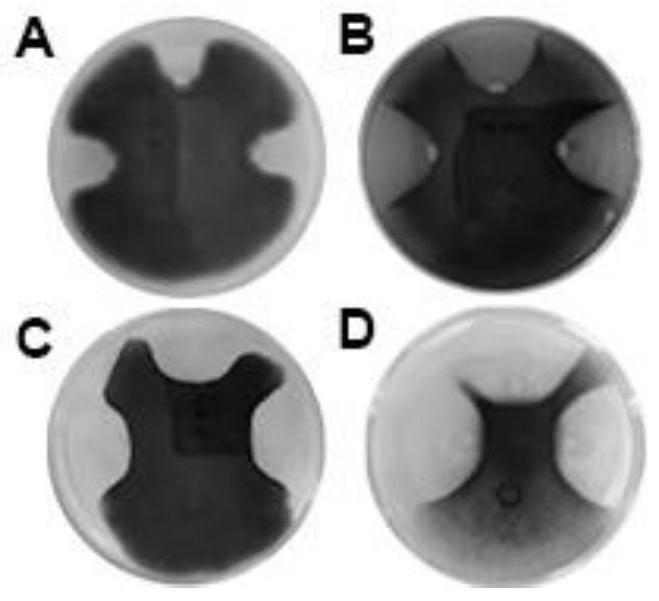Bacillus for degrading straw and inhibiting plant pathogenic fungi and application thereof
A technology for bacillus and plant fungal diseases, applied in the fields of application, plant growth regulators, and microbial-based methods, can solve problems such as crop diseases, affecting the effect of straw returning to the field, and threats to crop growth, and achieve a broad antibacterial spectrum Effect
- Summary
- Abstract
- Description
- Claims
- Application Information
AI Technical Summary
Problems solved by technology
Method used
Image
Examples
Embodiment 1
[0023] Example 1 Isolation of microorganisms from soil samples
[0024] Bacterial isolate samples were collected in Hebei Tangshan, Cangzhou, Handan Daming, Shijiazhuang Zhengding, Xingtang and other cities and counties and rural areas, soil and field waste straw in crop growth areas. Take 2 g of farmland soil, add it to a conical flask containing 20 mL of sterile distilled water, and shake at 180 rpm for 20 min at 25°C. Take 1 mL of soil suspension, add it to a 1.5 mL EP tube, and centrifuge at 10,000 × g at 25°C for 1 min. Take 100 μL of the soil supernatant after centrifugation and add it to a 1.5 mL EP tube containing 900 μL of sterile distilled water for gradient dilution. At this time, the dilution is 10 -1 ; Take 100 μL of the diluted solution, add it to a 1.5 mL EP tube containing 900 μL of sterile distilled water, and continue the gradient dilution, at this time the dilution is 10 -2 , and so on; take the dilution as 10 -3 , 10 -4 , 10 -5 The solution was coated ...
Embodiment 2
[0025] Example 2 Screening of cellulose-degrading bacteria and lignin-degrading bacteria
[0026] Screening of lignin-degrading bacteria: Take the pure cultured monoclonal strain, inoculate it into 5mL LB liquid medium, and cultivate with shaking at 150rpm for 48h at 24°C. Take 5 μL of bacterial liquid, put it on water agar-aniline blue medium, air dry, and invert at 24°C for 24h (such as figure 2 shown in A). Observe whether the aniline blue fades and forms a transparent area at the bacterial liquid.
[0027] Screening of cellulose-degrading bacteria: Take the pure cultured monoclonal strain, inoculate it into 5mL LB liquid medium, and cultivate with shaking at 24°C and 150rpm for 48h. Take 5 μL of bacterial liquid, put it into CMC-Na medium, dry it, and invert at 24°C for 24-48 hours, until the colony grows to an appropriate size. The above plate was stained with 1% Congo red staining solution for 15 min, and the Congo red staining solution was discarded. Destain the pl...
Embodiment 3
[0028] Example 3 Screening of antagonistic strains
[0029] Screening of antagonistic bacteria for the prevention and control of plant fungal diseases: inoculate a 5mm diameter pathogenic fungal plate into the center of a double-layer PDA solid medium (medium composition: potato 200g / L, glucose 20g / L, agar 13g / L), 24 ℃ Invert culture for 60h. Punch holes (2.5 mm in diameter) at 5 mm from the edge of the colony, and discard the upper medium. 8 μL of bacterial solution was added to the wells and incubated at 24°C for 72h. Observe if a zone of inhibition is formed around the fungus (eg image 3 shown).
PUM
 Login to View More
Login to View More Abstract
Description
Claims
Application Information
 Login to View More
Login to View More - R&D
- Intellectual Property
- Life Sciences
- Materials
- Tech Scout
- Unparalleled Data Quality
- Higher Quality Content
- 60% Fewer Hallucinations
Browse by: Latest US Patents, China's latest patents, Technical Efficacy Thesaurus, Application Domain, Technology Topic, Popular Technical Reports.
© 2025 PatSnap. All rights reserved.Legal|Privacy policy|Modern Slavery Act Transparency Statement|Sitemap|About US| Contact US: help@patsnap.com



